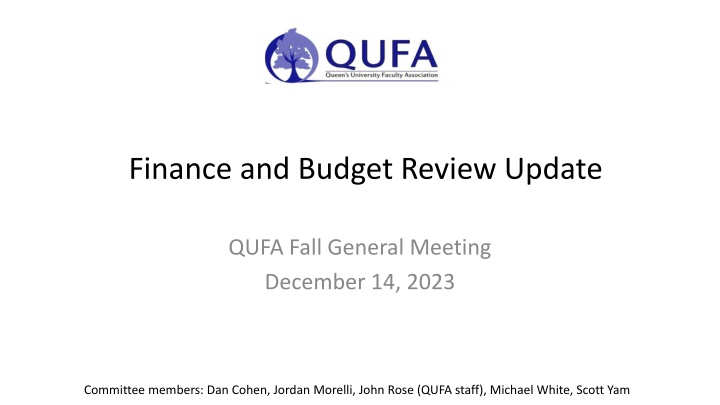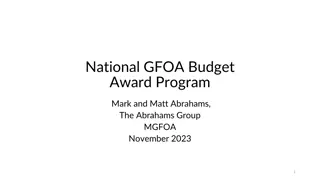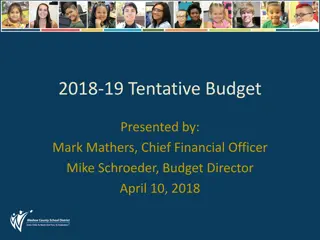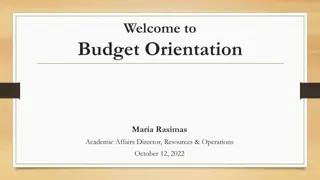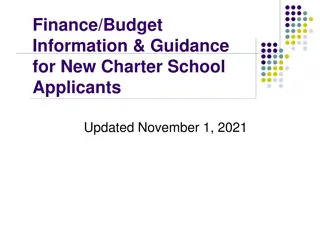Finance and Budget Review Update
Queen's University is grappling with financial difficulties following mandated tuition fee cuts and freezes, resulting in significant revenue impacts. Despite these challenges, the university managed to maintain a surplus. Various factors such as demographic changes, strategic misadventures, and political influences contribute to financial problems in universities. The revenue and expenses trend, along with operating revenue sources, shed light on Queen's University's financial situation.
Download Presentation

Please find below an Image/Link to download the presentation.
The content on the website is provided AS IS for your information and personal use only. It may not be sold, licensed, or shared on other websites without obtaining consent from the author.If you encounter any issues during the download, it is possible that the publisher has removed the file from their server.
You are allowed to download the files provided on this website for personal or commercial use, subject to the condition that they are used lawfully. All files are the property of their respective owners.
The content on the website is provided AS IS for your information and personal use only. It may not be sold, licensed, or shared on other websites without obtaining consent from the author.
E N D
Presentation Transcript
Finance and Budget Review Update QUFA Fall General Meeting December 14, 2023 Committee members: Dan Cohen, Jordan Morelli, John Rose (QUFA staff), Michael White, Scott Yam
What are the principal causes of financial problems at universities?
DEMOGRAPHICS Image: Yinan Chen - www.goodfreephotos.com (gallery, image), Public Domain, https://commons.wikimedia.org/w/index.php?curid=33633818a
Strategic Misadventures Image: McKernan, B. (2019, Jan. 28). Fate of castles in the air in Turkey s 151m ghost town. The Guardian, https://www.theguardian.com/world/2019/jan/28/fate-of-castles-in-the-air-in-turkeys-151m-ghost-town
Sources Financial statements Budget reports Office of Planning and Budget Student enrolments Employee headcounts Common University Data Ontario (CUDO) Council of Ontario Financial Officers (COFO) OCUFA University Finance Committee University finance dashboard
Revenue and Expenses 2019: Queen s becomes a billion $ organization (In millions) $1,200.00 $1,000.00 $800.00 $600.00 $400.00 $200.00 $0.00 2011 2012 2013 2014 2015 2016 2017 2018 2019 2020 2021 2022 2023 Revenue Expenses $180,000,000 in foregone revenue due to 10% tuition cut and freeze since 2019/2020. In the same period, still managed a surplus of $84,000,000. Source: Queen s University Consolidated Financial Statements, 2011-2023
Total Operating Revenue by Source Source: Queen s University Budget Report, 2023-2024, p. 21
Source: Queens University Consolidated Financial Statements, 2022-2023, p. 5
Commentary Queen s University is facing financial challenges, given the significant impacts of the provincially mandated 2019 tuition fee cut and subsequent freeze for Ontario students, the reduction in international enrolment post-pandemic and the cap on provincial funding for domestic students, along with inflationary pressures. As noted in previous years, annual investment returns reflect the volatility in financial markets. The $15.6 million surplus in the current year is primarily a result of stronger investment returns, which rebounded from $12.8 million in 2021-22 to $84.4 million in 2022-23. As reported in the consolidated statement of financial position, internally restricted net assets, which are a reflection of the financial flexibility of the institution, declined by $43.5 million in 2022-23. These balances are expected to be drawn down further in 2023-24 based on the significant projected operating budget deficit. The use of these reserves for on-going operational expenditures is not sustainable. To protect its academic mission while advancing its strategic priorities, the University will be implementing cost saving measures. Source: Queen s University Consolidated Financial Statements, 2022-2023, p. 2
Assets and Liabilities (In millions) $4,000.00 $3,500.00 $3,000.00 $2,500.00 $2,000.00 $1,500.00 $1,000.00 $500.00 $- 2011 2012 2013 2014 2015 2016 2017 2018 2019 2020 2021 2022 2023 Assets Liabilities Source: Queen s University Consolidated Financial Statements, 2011-2023
Assets (Endowments, Internally Restricted, Unrestricted, and Invested in Capital Assets) (In millions) $1,600.00 $1,400.00 $1,200.00 $1,000.00 $800.00 $600.00 $400.00 $200.00 $- 2011 2012 2013 2014 2015 2016 2017 2018 2019 2020 2021 2022 2023 -$200.00 -$400.00 Endowments Internallly Restricted Invested in Capital Assets Unrestricted Source: Queen s University Consolidated Financial Statements, 2011-2021
Cash (Asset) (in millions) 180.00 160.00 140.00 120.00 100.00 80.00 60.00 40.00 20.00 0.00 2011 2012 2013 2014 2015 2016 2017 2018 2019 2020 2021 2022 2023 Cash
Long-term Debt (Liability) (in millions) $125 million loan @ 2.89%, due 2063 $450.00 $400.00 $350.00 $300.00 $250.00 $200.00 $150.00 $100.00 $50.00 $0.00 2011 2012 2013 2014 2015 2016 2017 2018 2019 2020 2021 2022 2023 LTD Source: Queen s University Consolidated Financial Statements, 2011-2023
Operating Fund (Accounting basis) (in millions) $900.00 $800.00 $700.00 $600.00 $500.00 $400.00 $300.00 $200.00 $100.00 $0.00 2012 2013 2014 2015 2016 2017 2018 2019 2020 2021 2022 2023 Revenue Expenses Source: Queen s University Consolidated Financial Statements, 2011-2023
Expenditures by Functional Area, 2010-11 and 2020-21 $450,000 $400,000 $350,000 $300,000 $250,000 $200,000 $150,000 $100,000 $50,000 $0 Instruction and Research (excl. Medicine) Medicine - Instruction and Research Academic Support Library Student Services Central IT and Administration and General Physical Plant External Relations Ancillary Communications 2010-11 2020-21 Source: COFO
Expenditures by Functional Area, 2010-11 and 2020-21 2010-11 2020-21 Instruction and Research (excl. Medicine) 2%4% 9% Medicine - Instruction and Research 10% 2% Academic Support 3% Library 15% 40% 4% 43% Student Services Central IT and Communications 9% 2% Administration and General 1% 3% Physical Plant 9% 3% External Relations 3% 2% Ancillary 19% 17% Source: COFO
Enrolments (FTE and part-time) 2021-22: +0.36 % 40000 33842 33719 35000 31785 2011-21: +38.5 % 30386 29609 28272 30000 27257 27149 26982 26780 26052 25997 24788 24777 24343 24270 24042 23228 25000 22472 22253 21619 2021-22: +1.02 % 20529 20282 19861 20000 15000 2011-21: +33 % 2011-21: +65.9 % 2021-22: -2.25 % 10000 6737 6585 5733 5598 5339 5044 4677 4527 4378 4248 4181 4061 5000 0 2011 2012 2013 2014 2015 2016 2017 2018 2019 2020 2021 2022 Undergraduate Graduate Total Source: Queen s Office of Planning and Budget
International Students 4000 ~5.3 % of total in 2011 ~12.1 % of total in 2020-21 ~11.1 % of total in 2022-23 3500 3000 2500 2000 1500 1000 500 ? 0 2011 2012 2013 2014 2015 2016 2017 2018 2019 2020 2021 2022 2023 Undergraduate Graduate Source: Institutional Research and Planning
QU Financial Statement Summary 2011 2021 2022 2023 Change Change Revenue $742.5 $1,095.3 47.5 % $1,008.8 $1,125.8 11.6 % Expenses $751.2 $950.5 26.5 % $1,012.1 $1,110.2 9.7 % Op fund revenue $435.9 (2014) $752.9 72.7 % $684.63 $735.98 7.5 % Op fund expenses $398.5 (2014) $662.1 66.1 % $706.89 $786.46 11.3 % Assets $1,701.6 $3,393 99.4 % $3,397 $3,472.5 2.2 % Endowments $557.7 $1,393.7 149.9 % $1,407 $1,448.2 2.9 % Cash $66.1 $165.6 150.5 % $118.9 $96.84 -18.6 % Liabilities $970.5 $1,402.6 44.5 % $1,374.3 $1,415.2 3.0 % Long-term debt $227.17 $381.15 67.8 % $376.81 $372.34 -1.2 % Enrolment (ft+pt) 24,343 33,719 38.5 % 33,842 NA - Faculty (TT/CA) 792/105 860/134 8.6%/27.6% 866/? NA - (millions)
Comparison: Surplus(Deficits) Source: OCUFA University Financial Statements Database, 2022
Comparison: Salary & Benifits Source: OCUFA University Financial Statements Database, 2022
Revenues, expenses, long-term debt From 2011-2021, Queen's revenues increased 47.5 percent while its expenses have increased only 26.5 percent. In 2019, Queen's had revenues of more than $1 billion. Since 2013, Queen's has had annual surpluses totaling $631 million and one annual (2022) deficit of $3.3 million. In 2023, Queen s $15.3 million. Long-term debt was relatively stable from 2011-2015 at about $225 million. It increased 15 percent in 2016 to $276 million. It increased again in 2020 by 46 percent to $385 million. The 2020 increase was mainly due to the University establishing a series B unsecured debt of $125 million at 2.89 %, which matures in April 2060.
Summary Annual financial reports provide only a snapshot of the financial health of an institution. Long-term trends are much better indicators of financial health. Universities do not go bankrupt overnight. The warning signs are often present years or even decades before a crisis hits. Financial problems often arise due to demographic challenges (declining enrolment) or strategic misadventures (costly buildings or new campuses).
